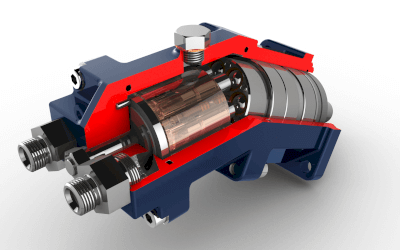What Is an Axial Flow Pump?

Axial flow pumps are pumps in which the flow discharged from the impeller is concentric with the main shaft.
Multiple impellers are attached to a rotating shaft, and the impellers exert pressure and velocity energy on the fluid through their lifting action. The velocity energy of the fluid exiting parallel to the shaft is then converted to pressure energy by a fixed guide vane.
Axial flow pumps are used for drainage, irrigation, and other applications where large flow rates and little pressure are required.
Uses of Axial Flow Pumps
Axial flow pumps are used in a variety of industrial applications because of their low aerodynamic losses, compact size, and relative ease of handling.
Examples include cooling water in power plants, condensers in steam turbines, water and sewage systems, and water circulation and wastewater in the chemical industry. Other applications include river drainage, irrigation, food and beverage industries, oil and gas, and mining.
Principle of Axial Flow Pumps
Axial flow pumps are classified as turbo type pumps. It has a structure of radially arranged vanes on a cylindrical rotating shaft, and centrifugal force is created by the high-speed rotation of the impeller.
The impeller is similar in shape to the wings of an airplane. In Axial Flow Pumps, the blades are fixed to the impeller and rotate. The lift force acting on the impeller creates an axial flow force and discharges the liquid.
Structure of Axial Flow Pumps
Axial flow pumps consist of a casing, impeller, fixed impeller, main shaft, bearings, and shaft seal.
1. Casing
The casing houses the rotor, which consists of the impeller and shaft, and has a pressure-resistant structure to dispense liquid efficiently.
2. Impeller
The impeller has multiple blades that rotate to expel the fluid. The fixed blades change the swirling flow into an axial direction and convert velocity energy into pressure.
3. Spindle
The main shaft is the part of the impeller that is attached to and rotates the impeller and transmits the necessary power to the impeller.
4. Bearing
The bearing supports the spindle and impeller and is an important component for stable pump operation.
5. Shaft Seal
The shaft seal will seal water leakage through the penetration between the shaft and casing.
Features of Axial Flow Pumps
- High-speed operation allows for compact size and light weight.
- Large head change relative to flow rate change, narrow operating range
- The power of the tightening shaft is more than twice of the rated power, which is a disadvantage. Vibration increases during clamping, so it is usually not used.
- Pump efficiency is at a slightly lower level than mixed flow pumps.
- Axial flow pumps are mainly suited for applications with large flow rates and small heads
How to Select Axial Flow Pumps
The major factors that determine pump specifications are flow rate and pressure. Pressure can be converted to m, the same unit of potential energy, and is called head or head. The criteria for selecting which type of turbo pump to use based on flow rate and pressure are generally as follows:
- If the flow rate is low but the head is high, select a centrifugal pump.
- Axial flow pumps should be selected when the flow rate is high and the head is small.
- Mixed flow pumps are selected when the flow rate is relatively high, and some head is required.
Other Information on Axial Flow Pumps
Pump Cavitation
Pumps can experience a problem called cavitation. At the inlet of the pump’s impeller, the higher velocity of the fluid increases the velocity energy, which in turn reduces the inlet pressure, i.e., the static pressure.
When the pressure at the impeller inlet drops below the saturated vapor pressure of water at that temperature, the water vaporizes into steam and bubbles are generated. This phenomenon is cavitation.
If the pump continues to operate in this manner, the bubbles repeatedly generate and dissipate, generating shock waves. The shock wave strikes the impeller blade surface, causing gradual erosion of the surface. This is cavitation erosion.
If cavitation continues, the bubbles do not dissipate and the suction area becomes covered with bubbles, making it impossible for the pump to function. Even if there is sufficient margin for cavitation to occur at the rated operating flow rate of the pump, cavitation will occur in the small flow rate range. The countermeasures against cavitation are to increase the minimum operating flow rate or to use a variable pump speed.